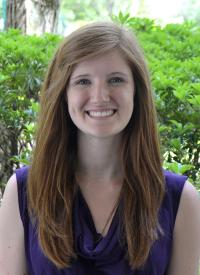You are here
Maria McQuillan
University of Saint Thomas
NASA Goddard Space Center Intern

NASA Goddard Space Flight Center
Position details
Coronal Heating and the Origin of the Solar Wind
Why is the Sun's atmosphere—the solar corona—so hot at a million degrees? Which regions of the hot solar corona are accelerated to become the solar wind, and how? These are fundamental, unanswered questions about the Sun and the solar wind in which the Earth lives, which Maria is investigating through analyzing data analysis. Maria is researching the basics of time series analysis and image processing by contributing to two research projects. The first is the analysis of a series of images of the solar corona to identify patterns in the coronal heating. The second is the analysis of plasma measurements of the solar wind to identify fluctuations in composition.
Final presentation
Solar weather has become increasingly important as scientists and spacecraft extend their reach further into the universe. Solar wind impacts the Earth and our satellites every day, but it is not completely understood. For example, the origin of the slow solar wind has been debated for many years. One theory states that the slow wind occurs in areas with a high radial expansion factor [Wang et al., 1996], while another theory contends that it occurs from magnetic reconnection along boundaries of a web of coronal hole corridors [Antiochos et al., 2011]. Both of these theories are compelling and can describe all the observed large-scale characteristics of the slow solar wind, but neither has been tested on smaller scales. We present a case study where we relate in-situ data at Earth to imaging data at the Sun of a pseudo-streamer observed at Earth on August 9th 2008 [N. U. Cooker et al., 2014]. Pseudo-streamers are a particular type of slow solar wind that does not occur near the heliospheric current sheet (HCS). Since some theories rely on the HCS to explain the behavior of the slow wind, the pseudo-streamer is of particular interest. This streamer was analyzed for periodic density structures that may be associated with the slow solar wind. Density structures were identified using ACE and WIND’s in-situ data and analyzed in STEREO Ahead’s Heliospheric Imager 1(HI1) field of view. Spectral analysis was performed on both in-situ and optical data. Results showed definite periodic structures in the in-situ data and that the solar wind with the periodic structures did not come from near the HCS. The exact stream of solar wind that produced the periodic structures at the Sun is still in question, but the fact that the wind does not originate from the HCS compels us to continue searching for how these structures were formed.
This fall, I will be a senior at the University of St. Thomas in St. Paul, Minnesota. I am studying for a BS in physics with a minor in mathematics. In my past three years at St. Thomas, I have done research for various professors, swam on the swimming and diving team, and been a member of rock climbing club and sustainability club. After I graduate, I plan to go on to graduate school for either astrophysics or geophysics.
I am an outdoor and environmental enthusiast. I am a bit nervous to spend my summer in such a dense city, but I am also excited to experience big city living. I can’t express how happy I am to have been chosen as one of SPS’s Goddard Space Flight Center interns. It has been one of my biggest dreams to work for NASA, and I could not be more excited to engage in the Goddard community. I hope my time at Goddard will provide me with a broader view in astronomy research and hopefully some insight in what to study in graduate school.

